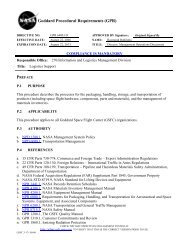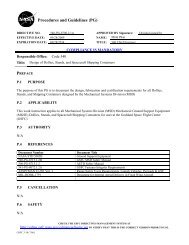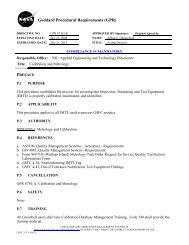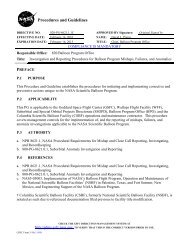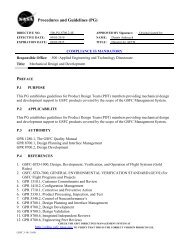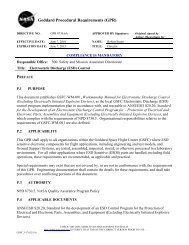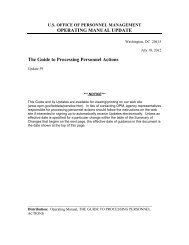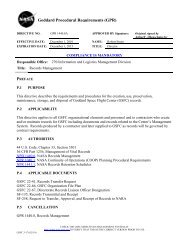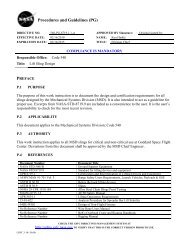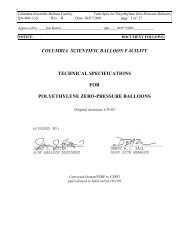ANSI ESD S20.20-2007 - FOIA and eLibrary website! - NASA
ANSI ESD S20.20-2007 - FOIA and eLibrary website! - NASA
ANSI ESD S20.20-2007 - FOIA and eLibrary website! - NASA
Create successful ePaper yourself
Turn your PDF publications into a flip-book with our unique Google optimized e-Paper software.
<strong>ANSI</strong>/<strong>ESD</strong> <strong>S20.20</strong>-<strong>2007</strong>level in the real world. The assumption for this test model is that the device itself has becomecharged <strong>and</strong> rapid discharge occurs when the charged device’s conductive leads contact aconductive surface, which is at a lower potential. An issue with the preparation of a CDM testst<strong>and</strong>ard is the availability of suitable instrumentation to measure the discharge event. Thewaveform rise time is often less than 200 picoseconds. The entire event can take place in lessthan 2.0 nanoseconds. Although very short in duration, current levels can reach several tens ofamperes during discharge.Table 4. <strong>ESD</strong> Susceptibility Test References for Devices<strong>ESD</strong>ModelHBM<strong>ESD</strong> St<strong>and</strong>ards <strong>and</strong> Methods for Susceptibility Testing of Devices<strong>ANSI</strong>/<strong>ESD</strong> STM5.1MIL-STD-883 Method 3015MIL-STD-750 Method 1020MIL-PRF-19500MIL-PRF-38535MMCDM<strong>ANSI</strong>/<strong>ESD</strong> STM5.2<strong>ANSI</strong>/<strong>ESD</strong> STM5.3.1Assembly, Equipment <strong>and</strong> Design Hardening1. Assembly, Equipment <strong>and</strong> Design Hardening GuidanceAssemblies <strong>and</strong> equipment should have protective circuitry or techniques to meet the desireddesign goals. Determining the <strong>ESD</strong> susceptibility of assemblies <strong>and</strong> equipment may be based onsimulation modeling, or actual testing. Table 5 provides a quick reference for various testmethods associated with assembly <strong>and</strong> equipment susceptibility testing.2. Direct Contact, Non-Operating Assembly, Body/Finger or H<strong>and</strong>/Metal TestsThis model can be used to verify that assemblies will not be damaged during non-operatingconditions by direct contact to input, output <strong>and</strong> interface connections. This threat applies to alltypes of assemblies (see Table 5).3. Direct Contact Operating Equipment H<strong>and</strong>/Metal TestThis model can be used to verify that operating equipment will not be damaged (or nonrecoverablefaults will not be injected) by direct contact to operator accessible points <strong>and</strong>exposed surface areas during the normal maintenance process. This threat is limited toequipment subject to operator adjustments or maintenance activities during operation (seeTable 5).4. Indirect Contact, Operating Equipment Furniture Model TestThis model can be used to verify that operating equipment in a home or office environment willnot be damaged (or non-recoverable faults will not be injected) by indirect contact during normalactivities performed within the proximity of the equipment. This threat applies to all electronicequipment in a home or office environment (see Table 5).Copyright 2010 by <strong>ESD</strong> Association. Licensed, by agreement, for enterpise-wide use to <strong>NASA</strong>.No other reproduction or transmission in any form is permitted without written permission of the <strong>ESD</strong>A.For inquiries or to report unauthorized use, contact info@esda.org.10



